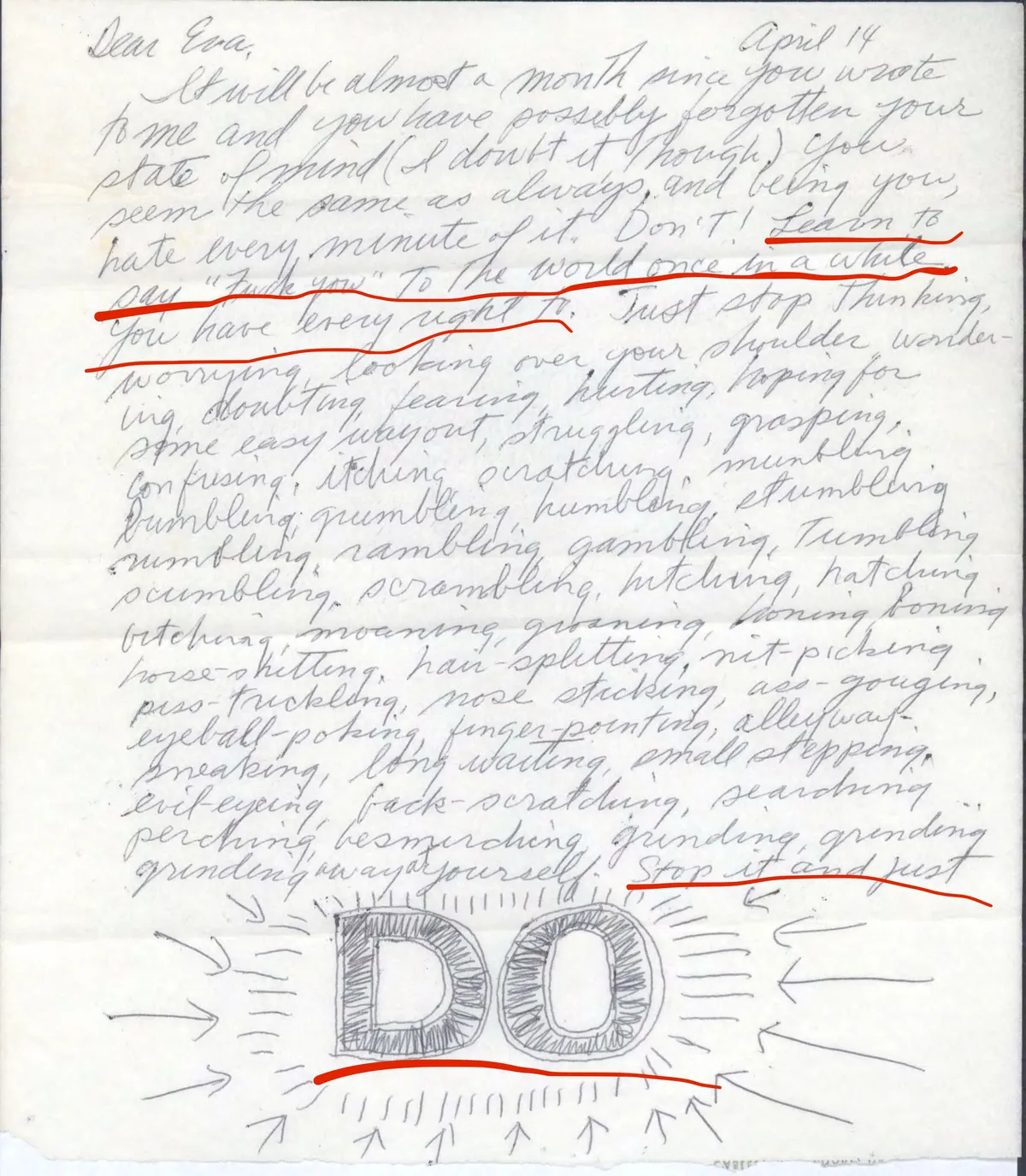"DO!" Sol LeWitt's Fierce, Funny, Extraordinary Letter to Eva Hesse
Learn to say “Fuck You” to the world once in a while. You have every right to. Just stop thinking, worrying, looking over your shoulder, wondering, doubting, fearing, hurting, hoping for some easy way out, struggling, grasping, confusing, itching, scratching, mumbling, bumbling, grumbling, humbling, stumbling, numbling, rambling, gambling, tumbling, scumbling, scrambling, hitching, hatching, bitching, moaning, groaning, honing, boning, horse-shitting, hair-splitting, nit-picking, piss-trickling, nose sticking, ass-gouging, eyeball-poking, finger-pointing, alleyway-sneaking, long waiting, small stepping, evil-eyeing, back-scratching, searching, perching, besmirching, grinding, grinding, grinding away at yourself. Stop it and just DO.
-Sol LeWitt to Eva Hesse (April 1965)
Sol LeWitt and Eva Hesse met in 1960 in downtown New York as two young forces orbiting the restless, postwar avant-garde art world. LeWitt was 32, a rising figure in conceptual and minimalist art. Hesse was 24, a German-born sculptor still finding her form. They hailed from different worlds and had radically different styles, but something clicked.
Her vulnerability sharpened his clarity. His structure steadied her chaos. They formed a deep, enduring bond — equal parts adoration, admiration, and creative combustion. It was the kind of friendship most people never find. Rooted in beauty, raw affection, full of tension and tenderness, challenge and care. Two artists, two people, who saw each other clearly, and made each other braver.
LeWitt revered Hesse. He saw in her a brilliance she struggled to see in herself. Her work was messy, raw, fragile, alive. He understood what she was doing when few others did. Many who saw their relationship as a mentor-protégé completely missed the real shape of their bond. Theirs was a relationship of equals. Deeply connected. Fiercely mutual. Intellectually electric. Emotionally rare.
In the spring of 1965, Hesse was living in Germany, alone and adrift, creatively blocked and full of doubt. She wrote to LeWitt in despair. Her work was worthless, she didn't belong, she might never make anything meaningful. What she received in return was a five-page, profanity-laced bolt of clarity and encouragement.
LeWitt didn't coddle Hesse. He had no patience for her self-doubt. With a single, unforgettable directive he commanded her: "Stop thinking and just DO!"
His fierce, funny, now-famous handwritten letter has since become one of the great manifestos of creative courage. A love letter to the act of making. And, one of the most powerful letters ever written to an artist in crisis.
Hesse and LeWitt remained close for the next five years, exchanging letters, visiting studios, watching each other's work evolve in wildly different but parallel ways. Then, in 1970, Hesse died suddenly, tragically from a brain tumor. She was just 34.
After her death, LeWitt created several tributes. One of the most haunting was Wall Drawing #46, composed entirely of "not straight" lines. His clean world, bent by grief.
LeWitt’s Letter To Hesse (April 14, 1965)
What follows is the full text of LeWitt's extraordinary letter to Hesse.




